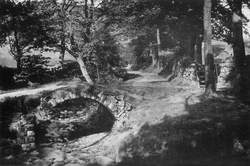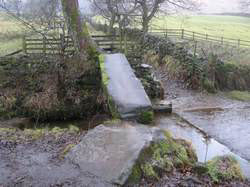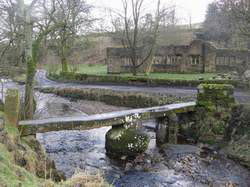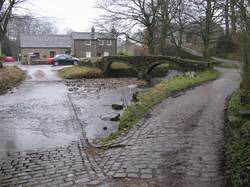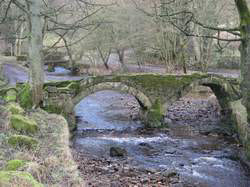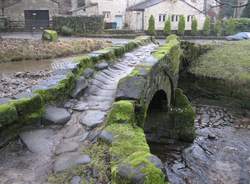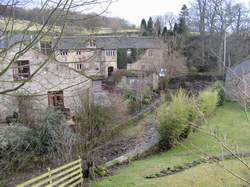Abandoned Communities ..... Wycoller
I have postponed until last an account of Wycoller's most special attraction, the astonishing series of bridges that cross the beck. There are eight bridges, and in addition three fords can be seen that would have carried wheeled traffic across the beck. Very little is known about the origins and history of most of the bridges. In most cases we have no idea how old they are. More precise dating might be possible if systematic comparisons were made with bridges elsewhere whose dates are known, but as far as I know no one has tried to do this. I will start upstream and work down Wycoller Beck.
The first bridge stands at the junction of the stream from Turnhole Clough and the beck. The present bridge is modern, but it replaced a single arched bridge that would have carried farm carts over the beck.
The next bridge is a clam bridge, a single slab of stone with stone supports at each end. I assume it has been used only as a foot bridge. Holes can be seen on its upper surface that once held posts supporting a hand rail. The clam bridge was swept downstream by floods in 1989 and again the following year. It broke into three parts, but it was repaired and a concrete stake now secures it to the east bank of the beck.
Another single arched road bridge crosses the beck below Copy House, and then you come to the clapper bridge. The clapper bridge consists of three blocks of stone supported at each bank and by two piers standing in the beck. Originally it probably had two blocks and a single pier. The surface of the clapper bridge used to have a deep groove as a result of the use it had had, but in 1910 the surface was made much smoother. It is said that a farmer chiselled it flat after his daughter had a fatal accident at the bridge.
The clapper bridge would have carried pedestrians and pack-horses. A ford was constructed beside it to enable carts to cross. The ford and the road next to it are paved with setts probably laid down in the early nineteenth century, but in the river are several large flat stones, taken from the vaccary walls, that may previously have formed the surface of the ford.
Just beyond the ford there is a pack-horse bridge with two arches. The voussoirs, the stones that form each arch, run the full width of the bridge. The western arch appears crooked but is in fact completely stable. Its foundation stone at the bank is not level, but the stones above it were laid in such a way that a strong arch was created.
Before it leaves the village Wycoller Beck passes under three further bridges at Pearson's Farm, Laithe Hills Cottage, and Lowlands Farm. All of these bridges have a single arch and carry a narrow road.
The first bridge stands at the junction of the stream from Turnhole Clough and the beck. The present bridge is modern, but it replaced a single arched bridge that would have carried farm carts over the beck.
The next bridge is a clam bridge, a single slab of stone with stone supports at each end. I assume it has been used only as a foot bridge. Holes can be seen on its upper surface that once held posts supporting a hand rail. The clam bridge was swept downstream by floods in 1989 and again the following year. It broke into three parts, but it was repaired and a concrete stake now secures it to the east bank of the beck.
Another single arched road bridge crosses the beck below Copy House, and then you come to the clapper bridge. The clapper bridge consists of three blocks of stone supported at each bank and by two piers standing in the beck. Originally it probably had two blocks and a single pier. The surface of the clapper bridge used to have a deep groove as a result of the use it had had, but in 1910 the surface was made much smoother. It is said that a farmer chiselled it flat after his daughter had a fatal accident at the bridge.
The clapper bridge would have carried pedestrians and pack-
Just beyond the ford there is a pack-
Before it leaves the village Wycoller Beck passes under three further bridges at Pearson's Farm, Laithe Hills Cottage, and Lowlands Farm. All of these bridges have a single arch and carry a narrow road.
Five
The bridge at the foot of Turnhole Clough
The clam bridge
The clapper bridge, with part of Wycoller Hall in the background
The ford, the pack-
The pack-
The pack-
Looking across the village towards Pearson’s Farm and the bridge beside it.
